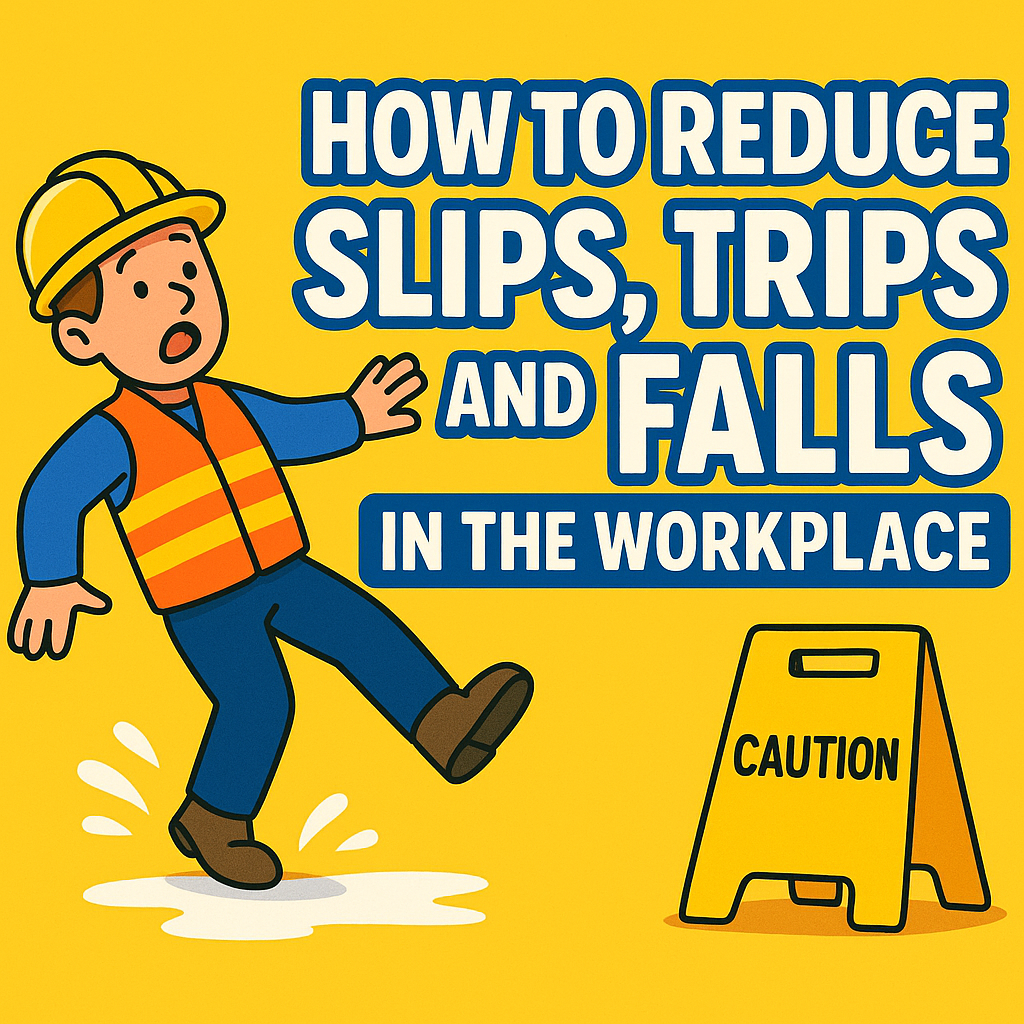Slips, trips, and falls are among the most common causes of workplace injuries, according to both OSHA and the Canadian Centre for Occupational Health and Safety (CCOHS). They can result in anything from minor bruises to serious fractures or even fatalities. The good news? These accidents are highly preventable.
In this article, we’ll explore how to reduce slips, trips, and falls in the workplace using proven safety strategies, employee habits, and engineering controls.
- 🚨 Why It Matters
- 🧹 1. Maintain Clean and Dry Floors
- 📢 2. Use Signage and Floor Markings
- 👟 3. Require Proper Footwear
- 🔧 4. Fix Flooring and Walkway Hazards Promptly
- 🔦 5. Improve Lighting Throughout the Workplace
- 🧰 6. Train Employees on Fall Awareness
- 🪜 7. Use the Right Equipment for Elevated Work
- 📋 8. Conduct Regular Safety Audits and Incident Reviews
- 🧠 9. Encourage a Safety-First Mindset
- 🧊 10. Plan for Seasonal Risks
- ✅ Quick Checklist: How to Reduce Slips, Trips, and Falls
🚨 Why It Matters
Slips, trips, and falls account for:
- Over 30% of lost-time injuries
- Increased compensation costs
- Productivity loss due to injury recovery
- Increased liability and legal exposure
Whether you’re managing an office, warehouse, retail space, or construction site, tackling these hazards should be a top priority.
🧹 1. Maintain Clean and Dry Floors
Spilled coffee or wet entrances can become instant hazards. Keep surfaces clean and dry by:
- Mopping up spills immediately
- Using absorbent mats in wet zones (entryways, kitchens)
- Installing anti-slip mats in areas with high moisture (e.g., industrial wash stations)
- Keeping walkways clear of clutter and debris
Internal link: Learn more from our post on Top Daily Habits That Keep the Workplace Safe.
📢 2. Use Signage and Floor Markings
Highlighting risks ensures visibility and awareness:
- Use “Wet Floor” signs when cleaning
- Place caution signage near sloped or uneven flooring
- Apply floor tape or glow strips on steps, ledges, and dark areas
- Add color-coded markings to differentiate between pedestrian and equipment zones
Signage is especially vital in facilities with multilingual staff—use universal symbols when possible.
👟 3. Require Proper Footwear
Footwear plays a big role in fall prevention. Require shoes with:
- Non-slip soles
- Proper ankle support
- Weather-appropriate materials
- Steel toes in heavy-duty environments
Conduct seasonal reminders about winter boots or anti-slip ice cleats.
🔧 4. Fix Flooring and Walkway Hazards Promptly
Look for issues such as:
- Loose tiles or floorboards
- Torn carpets or curled mats
- Uneven steps
- Cords and cables stretched across walkways
Conduct weekly safety walks to identify and fix these hazards early.
🔦 5. Improve Lighting Throughout the Workplace
Poor lighting contributes to missteps and missed hazards. To improve visibility:
- Use bright, energy-efficient LEDs
- Install motion sensors in rarely used areas (storage rooms, stairwells)
- Clean light fixtures regularly
- Ensure exterior walkways and parking lots are illuminated after dark
Good lighting also supports surveillance and emergency response.
🧰 6. Train Employees on Fall Awareness
Safety awareness is everyone’s responsibility. Regular training should cover:
- Identifying and reporting fall hazards
- Proper cleaning procedures
- Ladder safety and stair etiquette
- Emergency response protocols
Include toolbox talks and short monthly refreshers to keep knowledge fresh.
🪜 7. Use the Right Equipment for Elevated Work
For jobs involving heights, ladders, or platforms:
- Ensure ladders are the right height and on stable footing
- Provide fall protection gear when working above 6 feet (per OSHA)
- Never substitute chairs, boxes, or crates as step stools
- Use scaffolds or lifts with proper guardrails
Include visual inspections of equipment before every use.
📋 8. Conduct Regular Safety Audits and Incident Reviews
Routine inspections help spot trends and hazards. Use a slip-trip-fall inspection checklist that includes:
| Area | Checkpoints |
|---|---|
| Entrances | Mats, wet floors, signage |
| Stairwells | Lighting, handrails, treads |
| Production zones | Spills, obstructions, walking surfaces |
| Outdoor walkways | Ice, snow, uneven surfaces |
| Cords & cables | Secured and out of footpaths |
Review all incident and near-miss reports monthly to identify root causes.
🧠 9. Encourage a Safety-First Mindset
Safety culture reinforces daily habits:
- Reward teams with low incident rates
- Recognize employees who report hazards
- Involve employees in inspections and solution brainstorming
- Display monthly stats and safety tips in common areas
Use platforms like OHSE.ca for Canadian-focused safety content and posters.
🧊 10. Plan for Seasonal Risks
Slips and falls spike in winter due to:
- Ice buildup at entrances
- Wet floors from snow boots
- Reduced daylight hours
To counter this:
- Use ice melt and sand daily
- Provide entrance mats and boot brushes
- Schedule snow removal and salting procedures
For summer, address risks like wet floors from HVAC condensation or slippery outdoor decks.
✅ Quick Checklist: How to Reduce Slips, Trips, and Falls
| ✅ Habit or Strategy | 📍 Status |
|---|---|
| Mop spills immediately | ✔️ In place |
| Use warning signs and barriers | ✔️ In place |
| Fix loose flooring | ⬜️ Needs review |
| Enforce proper footwear policy | ✔️ In place |
| Improve lighting in all areas | ⬜️ Needs upgrade |
| Provide regular fall safety training | ✔️ Ongoing |
To reduce slips, trips, and falls in the workplace, you don’t need complex programs—just consistency and a proactive mindset. From clean floors to visible signage and proper footwear, it’s the daily routines that make the biggest difference.
Safety begins with awareness. Let these tips guide your team in creating a fall-free environment that supports health, productivity, and peace of mind.

